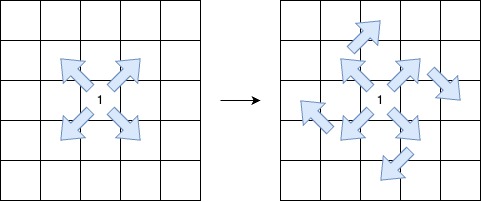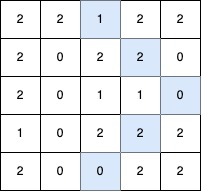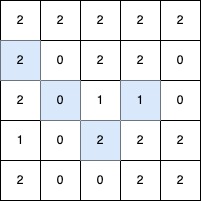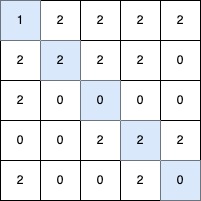2025-08-27 Daily Challenge
Today I have done leetcode's August LeetCoding Challenge with cpp.
August LeetCoding Challenge 27
Description
Length of Longest V-Shaped Diagonal Segment
You are given a 2D integer matrix grid of size n x m, where each element is either 0, 1, or 2.
A V-shaped diagonal segment is defined as:
- The segment starts with
1. - The subsequent elements follow this infinite sequence:
2, 0, 2, 0, .... - The segment:
- Starts along a diagonal direction (top-left to bottom-right, bottom-right to top-left, top-right to bottom-left, or bottom-left to top-right).
- Continues the sequence in the same diagonal direction.
- Makes at most one clockwise 90-degree turn to another diagonal direction while maintaining the sequence.

Return the length of the longest V-shaped diagonal segment. If no valid segment exists, return 0.
Example 1:
Input: grid = [[2,2,1,2,2],[2,0,2,2,0],[2,0,1,1,0],[1,0,2,2,2],[2,0,0,2,2]]
Output: 5
Explanation:

The longest V-shaped diagonal segment has a length of 5 and follows these coordinates: (0,2) → (1,3) → (2,4), takes a 90-degree clockwise turn at (2,4), and continues as (3,3) → (4,2).
Example 2:
Input: grid = [[2,2,2,2,2],[2,0,2,2,0],[2,0,1,1,0],[1,0,2,2,2],[2,0,0,2,2]]
Output: 4
Explanation:

The longest V-shaped diagonal segment has a length of 4 and follows these coordinates: (2,3) → (3,2), takes a 90-degree clockwise turn at (3,2), and continues as (2,1) → (1,0).
Example 3:
Input: grid = [[1,2,2,2,2],[2,2,2,2,0],[2,0,0,0,0],[0,0,2,2,2],[2,0,0,2,0]]
Output: 5
Explanation:

The longest V-shaped diagonal segment has a length of 5 and follows these coordinates: (0,0) → (1,1) → (2,2) → (3,3) → (4,4).
Example 4:
Input: grid = [[1]]
Output: 1
Explanation:
The longest V-shaped diagonal segment has a length of 1 and follows these coordinates: (0,0).
Constraints:
n == grid.lengthm == grid[i].length1 <= n, m <= 500grid[i][j]is either0,1or2.
Solution
class Solution {
const int MOVES[4][2] = {{1, 1}, {1, -1}, {-1, -1}, {-1, 1}};
int dfs(
int i,
int j,
int k,
int canTurn, int target,
vector<vector<int>>& grid,
vector<vector<vector<int>>>& memo)
{
i += MOVES[k][0];
j += MOVES[k][1];
if (i < 0 || i >= grid.size() || j < 0 || j >= grid[0].size() || grid[i][j] != target) {
return 0;
}
int mask = (k << 1) | canTurn;
if (memo[i][j][mask] > 0) return memo[i][j][mask];
int res = dfs(i, j, k, canTurn, 2 - target, grid, memo);
if (canTurn == 1) {
vector<int> maxs = {int(grid.size() - i - 1), j, i, (int)grid[0].size() - j - 1};
int nk = (k + 1) % 4;
if (maxs[nk] > res) {
res = max(res, dfs(i, j, nk, 0, 2 - target, grid, memo));
}
}
return memo[i][j][mask] = res + 1;
}
public:
int lenOfVDiagonal(vector<vector<int>>& grid) {
int m = grid.size();
int n = grid[0].size();
vector<vector<vector<int>>> memo(m, vector<vector<int>>(n, vector<int>(1 << 3, 0)));
int answer = 0;
for (int i = 0; i < m; i++) {
for (int j = 0; j < n; j++) {
if (grid[i][j] != 1) continue;
vector<int> maxs = {m - i, j + 1, i + 1, n - j};
for (int k = 0; k < 4; k++) {
if (maxs[k] > answer) {
answer = max(answer, dfs(i, j, k, 1, 2, grid, memo) + 1);
}
}
}
}
return answer;
}
};
// Accepted
// 561/561 cases passed (513 ms)
// Your runtime beats 59.5 % of cpp submissions
// Your memory usage beats 19.5 % of cpp submissions (298 MB)